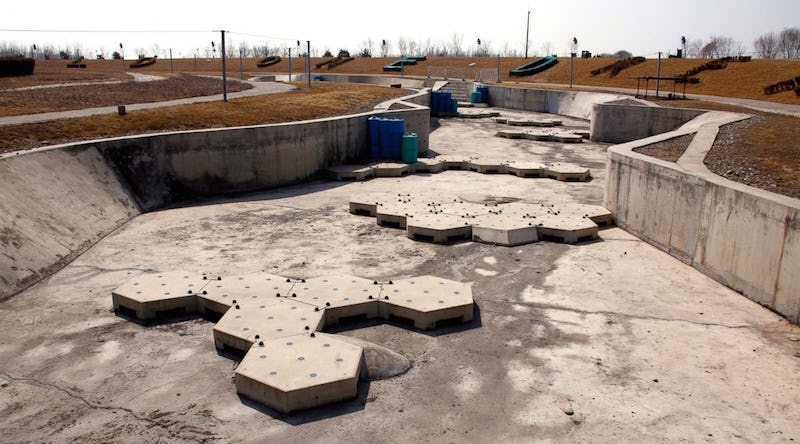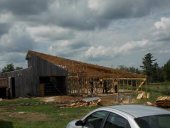
 6
6




 5
5






 7
7




 5
5




A human being should be able to change a diaper, plan an invasion, butcher a hog, conn a ship, design a building, write a sonnet, balance accounts, build a wall, set a bone, comfort the dying, take orders, give orders, cooperate, act alone, solve equations, analyze a new problem, pitch manure, program a computer, cook a tasty meal, fight efficiently, die gallantly. Specialization is for insects.
-Robert A. Heinlein

 9
9




 3
3




Chris Kott wrote:How it is used is crucial. If you "reinforce" it by pouring it around rebar, which, in the presence of moisture, which readily moves through concrete, swells as it rusts, destroying it from the inside in a matter of decades, it doesn't matter how long it would have lasted for. In that application, I think it's pretty vile.
If everything but the portland is sourced on-site, it becomes considerably less vile. Much less, if there's no rebar time-bomb embedded within it.
I think that the best use of portland is probably as 5-10% of a rammed earth or compressed earth block mix, which makes it go further and last longer. And no rebar time-bomb.
I think the other issue, though, is that of suitability for the task. Is concrete necessary in the application, or could it be done without?
-CK
'Theoretically this level of creeping Orwellian dynamics should ramp up our awareness, but what happens instead is that each alert becomes less and less effective because we're incredibly stupid.' - Jerry Holkins
 7
7




Learn to dance in the rain.
www.serenityhillhomestead.com
 4
4




Dillon Nichols wrote:So... how do you use concrete without steel/rebar, for reinforcement and for tying other materials into the concrete, in structural applications?
I am thinking specifically about A: earthquakes, a concern for any structure in my area, and B: shop and barn structures that will see heavy equipment in and around them...
I have seen coated rebar... it looked rather ineffective to me, any thoughts?
 5
5




 5
5




SKIP books, get 'em while they're hot!!! Skills to Inherit Property
 7
7




How it is used is crucial. If you "reinforce" it by pouring it around rebar, which, in the presence of moisture, which readily moves through concrete, swells as it rusts, destroying it from the inside in a matter of decades, it doesn't matter how long it would have lasted for. In that application, I think it's pretty vile.
 5
5




"The rule of no realm is mine. But all worthy things that are in peril as the world now stands, these are my care. And for my part, I shall not wholly fail in my task if anything that passes through this night can still grow fairer or bear fruit and flower again in days to come. For I too am a steward. Did you not know?" Gandolf
 1
1




 1
1








Travis Johnson wrote:I think for a lot of homesteaders and builders Earthcrete has its place, and I feel so strongly about that, that when I did my classes on sheep farming, I mentioned Earthcrete.
Earthcrete is using the existing soil, then mixing it with Portland cement, and then mixing in water and letting it harden. It can be mixed in a cement mixer too, but the greatest advantage of Earthcrete is in vast slabs. That is because it is so easy and cheap to make. A cement mixer is not even required!
All you do is take a rototiller and till up the soil to a consistent depth, say 4 or 6 inches. Then calculate how many bags of Portland cement you need to make an earthcrete slab that size and depth. I use 5 bags of Portland cement per cubic yard (27 cubic feet) of earthcrete. Spread the cement powder out as even as you can, and then rototill again until the earth/cement is consistently mixed. Now using a hose or buckets of water, add in the appropriate amount of water, and mix again with to rotortiller. After that, the earthcrete is troweled and finished just like you do any other concrete project.
And by the way, if you do not have a rototiller, they can be rented for a project like this.
 9
9




John Wolfram wrote:It probably depends on how much use the concrete structure gets, and for how long.
On the "not vile" end of the spectrum we have concrete that has been in service for a couple thousand years.

]
Chris Kott wrote:How it is used is crucial. If you "reinforce" it by pouring it around rebar, which, in the presence of moisture, which readily moves through concrete, swells as it rusts, destroying it from the inside in a matter of decades, it doesn't matter how long it would have lasted for. In that application, I think it's pretty vile.
Dillon Nichols wrote:
So... How do you use concrete without steel/rebar, for reinforcement and for tying other materials into the concrete, in structural applications?
Travis Johnson wrote:
You have to think of it like a floor joist, where the load is pressing down, so the top of the floor stringer is in COMPRESSION, and the bottom of the floor stringer is in tension. If a floor stringer was made out of concrete (like a concrete bridge girder) the top is very strong, but the bottom third needs steel to keep the concrete from pulling apart and cracking.
In a concrete slab, you have gravel or soil holding up the bottom of the slab, so there is very little tensile forces in the bottom third of the slab, it is all in compression, which is concretes greatest strength. In short, rebar is not required.
Dillon Nichols wrote:
I have seen coated rebar... it looked rather ineffective to me, any thoughts?
Travis Johnson wrote:
It gets down to the reality that concrete is incredibly robust in compression, but poor in tensile strength. With steel, the opposite holds true.
Travis Johnson wrote:
I just had a friend last week who is trying to build a house without a mortgage, but does not know much about building. He is pouring a concrete footer, and spent a whole day putting in rebar, and yet went with a three bag mix of concrete which is VERY weak. He actually should have saved his money and put in no rebar, and bought more bags of Portland cement per cubic yard. That is because we live in Maine, and most of Maine is within 10 feet of bedrock. He had to jackhammer the ledge so he could get a level footer. So he did not need rebar. His footer is 100% in full compression because it is sitting on ledge rock, and there is no "bending" to induce tensile strength forces in his footer. He should have put in more Portland cement though so his concrete does not fall apart under its compression load.




A human being should be able to change a diaper, plan an invasion, butcher a hog, conn a ship, design a building, write a sonnet, balance accounts, build a wall, set a bone, comfort the dying, take orders, give orders, cooperate, act alone, solve equations, analyze a new problem, pitch manure, program a computer, cook a tasty meal, fight efficiently, die gallantly. Specialization is for insects.
-Robert A. Heinlein
 5
5




Nerds be nerding...
 4
4




 I'm not really expert here, but that's the way it looks to me, so far.
I'm not really expert here, but that's the way it looks to me, so far.
 2
2




Country oriented nerd with primary interests in alternate energy in particular solar. Dabble in gardening, trees, cob, soil building and a host of others.
 8
8




 4
4




Chris Kott wrote:
"Something that lasts only 50 years without maintenance, and only 100 years with constant maintenance, doesn't qualify as permanent in my books. The remains of Roman projects are many times that old. "
 Natural or alternative building enthusiasts, and Permaculture enthusiasts, all need more aggressive lobbyists and public outreach.
Natural or alternative building enthusiasts, and Permaculture enthusiasts, all need more aggressive lobbyists and public outreach.
C. Letellier wrote: "Personally I consider concrete a good thing if it is well used. If used properly it is my belief it extends the lives of things like homes or reduces the labor or other energy costs. Things I expect to change, low use etc should not be made out of concrete but long life things or high use things most certainly concrete should be at least considered. I will disagree with the homes having a life expectancy of 30 to 50 years statement."
Rufus Laggren wrote:
"Concrete alternatives are not any stronger than concrete and they don't last any longer, right? So no structural or functional advantage there...
Concrete done incorrectly doesn't turn out well, but that is true of any process and concrete has a huge body of knowledge and installed base that all can reference, That means concrete work has a significantly better chance of turning out right
 2
2




 2
2




















Some places need to be wild
 2
2




 3
3








 1
1




At my age, Happy Hour is a nap.
 1
1




John Daley Bendigo, Australia The Enemy of progress is the hope of a perfect plan
Benefits of rainfall collection https://permies.com/t/88043/benefits-rainfall-collection
GOOD DEBT/ BAD DEBT https://permies.com/t/179218/mortgages-good-debt-bad-debt




John C Daley wrote:We live in a community with a standard of living that gives generally safe housing, safe buildings, safe drainage and safe services of all types.
Much of that is possible because of Concrete.
I cannot image a community with the standard of living expected in western countries doing so without concrete.
I find the suggestions it is 'vile', vile in itself.
John C Daley wrote:Life and communities are full of compromises and the use of many products are part of the whole picture.
The whole western world has striven to permit many freedoms for the populations, to have one group suggest another group use of a popular product surely must cross the boundary of decency.
'Theoretically this level of creeping Orwellian dynamics should ramp up our awareness, but what happens instead is that each alert becomes less and less effective because we're incredibly stupid.' - Jerry Holkins




John Daley Bendigo, Australia The Enemy of progress is the hope of a perfect plan
Benefits of rainfall collection https://permies.com/t/88043/benefits-rainfall-collection
GOOD DEBT/ BAD DEBT https://permies.com/t/179218/mortgages-good-debt-bad-debt

|
It runs on an internal combustion engine. This ad does not:
permaculture and gardener gifts (stocking stuffers?)
https://permies.com/wiki/permaculture-gifts-stocking-stuffers
|



